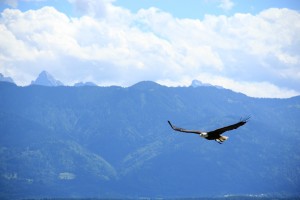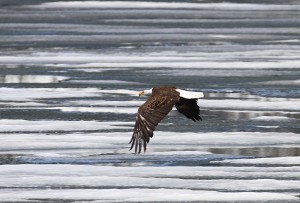Bald Eagles
Caretaker Patty Reagin writes a monthly blog on the flora and fauna of the Wet Mountain Valley called “Spotted” for San Isabel Land Protection Trust (SILPT), the non-profit that holds the conservation easement for Humboldt Peak Ranch. This post is re-posted here courtesy of SILPT.
Driving north on Highway 96 recently, we were enjoying a typical Colorado bluebird morning. The newly snowy mountains rose high above hay feels still tinted green, the snow blindingly white against the cloudless cerulean sky. Willows glowing gold with the last of the fall color wound through the meadows and past the highway following creeks edged with ice. The morning air was crisp, but the sun’s rays were warm, hinting at the pleasant afternoon to come. As we neared Beckwith Ranch, three very large raptors caught our eye, circling lazily, their heads as snowy as the mountains to the west. The bald eagles are back.
Bald eagles were very rare by the middle of last century due to trapping, shooting, poisoning, and reproduction issues caused by pesticides. They were protected under the Endangered Species Act in 1978 and since then, as a result of gentler treatment by humans, their strong recovery has been an incredible conservation success story. Bald eagles, symbol of the United States, can now once again be found throughout most of this country.
Generally, bald eagles nest in Alaska and northern Canada during the spring and summer, migrating south to spend their winters in the lower 48. Lucky for us, one of their wintering grounds is the Wet Mountain Valley. Bald eagles love water, and our winter visitors often congregate at Lake Deweese, sitting in trees and watching for fish. Seeing a bald eagle swoop down with talons forward to grab a fish from the water before stretching its 7-foot wingspan to climb back into the air, carrying dinner toward the top of a nearby tree, is breathtaking and well worth a few hours of birdwatching.
Fishing is a main source of meals, but bald eagles are not shy about stealing food from other birds midair, or chasing other creatures off carrion. Although today  bald eagles are one of the most beloved birds in our country, this thieving behavior earned bald eagles some rancor from prominent early Americans, including Benjamin Franklin and John James Audobon, who both considered the eagle to be of “bad moral character”, and not a proper emblem for the newly emerged America. Today, it’s hard to imagine any other symbol for our country!
bald eagles are one of the most beloved birds in our country, this thieving behavior earned bald eagles some rancor from prominent early Americans, including Benjamin Franklin and John James Audobon, who both considered the eagle to be of “bad moral character”, and not a proper emblem for the newly emerged America. Today, it’s hard to imagine any other symbol for our country!
Native Americans believe the eagle represents strength, swiftness, courage, and wisdom, and as we watched them fly it’s not hard to understand why. Majestic and powerful, they are a breathtaking sight soaring high against the rugged rock faces of the mountains. It’s a distinctly western image.
As the eagles grew small in the distance, we drove on, thankful to be living in a place where the water still flows and  the grasslands are still open and available for these incredible birds to come back, year after year, and delight us with their soaring presence during the quiet months of winter.
the grasslands are still open and available for these incredible birds to come back, year after year, and delight us with their soaring presence during the quiet months of winter.